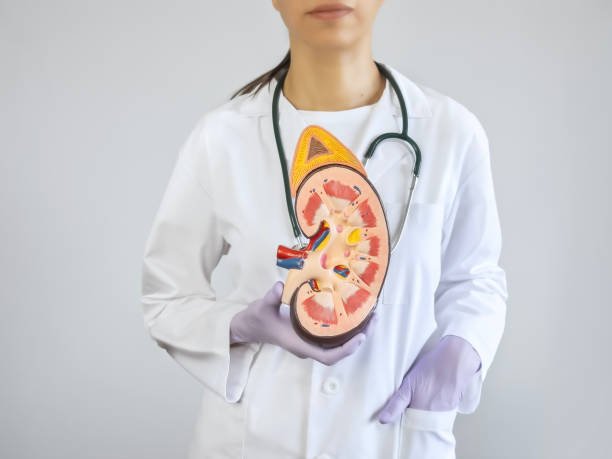When someone has stage 4 chronic kidney disease (CKD), it means their kidneys are pretty damaged, and their glomerular filtration rate (GFR) is down to 15-30 ml/min. This is serious, and they might need dialysis or a new kidney soon.
What is stage 4 kidney disease?
When we talk about stage 4 kidney disease, it means your kidneys have gone through some serious damage. Let’s break it down.
At the beginning (stage 1 and 2), your kidneys aren’t at 100%, but they’re still doing okay without showing many signs. By stage 3, about half of their healthy function is lost, and that’s when things can get more serious with symptoms popping up.
Now, if you’re in stage 4, it means your kidneys have taken a beating. This is the last stage before they might stop working completely (that’s what we call kidney failure or stage 5 kidney disease).
Doctors use two main tests to keep an eye on your kidneys. One is called eGFR (estimated glomerular filtration rate), a reliable way to check how well your kidneys are working. They look at things like your age, sex, ethnicity, and body size to get an accurate picture.
When your eGFR is between 15 and 29 milliliters per minute per 1.73 meters squared (ml/min/1.73m2), that’s stage 4 kidney disease. It means your kidneys aren’t doing their job properly, and you’re right on the edge before kidney failure.
But, hold on, eGFR might not be perfect in some situations, like if you’re pregnant, carrying some extra weight, or really muscular.
Doctors might also do a urine test to check for something called albumin. This is a protein in your blood, and healthy kidneys don’t let it slip into your urine. Finding it there helps doctors figure out how serious your kidney situation is.
They might even order an ultrasound or other imaging tests to take a closer look at your kidneys and figure out what’s causing the trouble.T
Symptoms of stage 4 kidney disease
In stage 4 kidney disease, people might notice various symptoms. These can include:
- Feeling tired a lot
- Swelling in the legs and shortness of breath
- Changes in how you pee, like it being foamy or a different color
- Pain in your back where the kidneys are
- Trouble sleeping because of leg cramps or restlessness
- Feeling sick and throwing up
- Weird tastes in your mouth, like a metallic flavor
- Bad breath because of too much urea in your blood
- Not feeling like eating
- Finding it hard to concentrate on things
- Problems with nerves, like numbness or tingling in your toes or fingers
Complications in Stage 4 CKD
When you’re in Stage 4 of kidney disease, there are often additional problems that can show up. These include:
- Anemia, which means having too few red blood cells
- Metabolic acidosis, when there’s too much acid in your blood
- Mineral and bone disorder, which happens when the balance of calcium and phosphorus in your blood is off, possibly leading to issues with your bones or heart
- Hyperkalemia, where there’s too much potassium in your blood
To keep an eye on these issues, it’s important to see your healthcare professional regularly, usually about four times a year. They can use simple blood tests to check for these complications.
People in Stage 4 CKD also have a higher chance of getting high blood pressure, so it’s crucial to regularly check your blood pressure as well.
What are the treatment options for Stage 4 Kidney Disease?
If you’re dealing with stage 4 kidney disease, your doctor might suggest a few ways to manage and slow down the progression of the condition. Let’s break it down.
1. Regular Check-ups:
You’ll probably be visiting a kidney specialist quite often (they call them nephrologists) to keep an eye on things. The American Kidney Fund suggests going every three months. During these visits, your doctor will do tests like eGFR blood tests and urine tests to check on your kidneys. They’ll also look into levels of stuff like potassium and phosphate in your blood.
2. Slowing it Down:
While there’s no cure for stage 4 kidney disease, there are ways to put the brakes on its progress. This involves keeping a close watch on and managing things like anemia, bone issues, diabetes, swelling, high cholesterol, and high blood pressure. Taking your medications as prescribed is super important to prevent kidney failure and heart problems. Your doctor might recommend medications like ACE inhibitors for blood pressure, calcium and vitamin D supplements, diuretics, erythropoiesis-stimulating agents (ESAs), or iron supplements. They’ll also advise avoiding certain meds, like nonsteroidal anti-inflammatory ones (NSAIDs), that could harm your kidneys.
3. Looking Ahead:
Because stage 4 is the last stop before kidney failure, your healthcare pro will chat with you about what might come next. If your kidneys hit that stage, there are a few options:
- Dialysis: This is a treatment to help your kidneys do their job.
- Kidney Transplant: Getting a new kidney from a donor.
- Supportive (Palliative) Care: This is care focused on keeping you comfortable and managing symptoms.
The National Kidney Foundation suggests considering dialysis when your kidney function drops to 15% or less. Once it goes below that, you’ve hit stage 5 kidney disease.
Stage 4 Kidney Disease diet
When you’re dealing with stage 4 kidney disease, what you eat can make a big difference. Here’s the lowdown, but remember to chat with your healthcare pro or ask for a diet expert’s advice.
What to Focus On:
- Go for fresh foods instead of processed ones.
- Keep your meat, poultry, and fish portions on the smaller side.
- Easy on the alcohol – better to go for none or just a bit.
- Watch out for cholesterol, saturated fats, and sugars. And hey, go easy on the salt.
Keeping an Eye on Phosphorus:
Phosphorus levels can be tricky, so keep an eye on them. Foods high in phosphorus include dairy products, nuts, peanut butter, dried beans, peas, lentils, cocoa, beer, dark cola, and bran.
Balancing Potassium:
If your potassium levels are high, you might need to cut back on bananas, melons, oranges, dried fruit, potatoes, tomatoes, avocados, dark leafy veggies, brown and wild rice, dairy foods, beans, peas, nuts, bran cereal, whole wheat bread, pasta, salt substitutes, and certain meats and fish.
Stay in the Loop with Your Pro:
Talk about your diet at every appointment with your healthcare pro. They might suggest tweaks after checking your latest test results.
Supplements and Fluids:
Ask your healthcare pro about any dietary supplements you might need. Also, check in on how much fluid you should be having.
Remember, your diet can play a crucial role, so keeping the conversation going with your healthcare pro is key!
FAQs
What causes stage 4 kidney disease?
Stage 4 kidney disease usually happens when your kidneys get seriously damaged over time. Diabetes and high blood pressure are common reasons. Sometimes, it’s just part of getting older.
Can I still eat my favorite foods with stage 4 kidney disease?
You might need to make some changes. Focus on fresh foods, watch your portions, and go easy on stuff like salt and certain fruits. Your doctor can guide you on what’s best for you.
Is stage 4 kidney disease curable?
Unfortunately, there’s no cure, but treatments can slow it down. The aim is to keep your kidneys working and maintain a good quality of life. Regular check-ups and following your treatment plan help a lot.
How long can I live with stage 4 kidney disease?
Life expectancy varies. It depends on factors like your age, overall health, and how well you stick to your treatment plan. Remember, treatments are getting better, so stay positive and take care of yourself.
What should I do if I have stage 4 kidney disease?
Stay in touch with your healthcare team. Regular check-ups, following your treatment plan, and making lifestyle adjustments are key. Talk to your doctor about diet changes, medications, and what to expect in the future.


